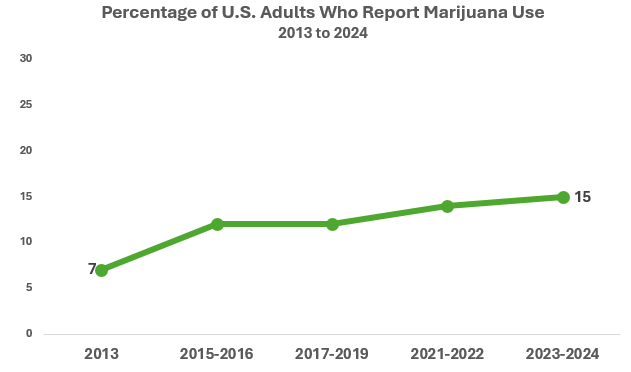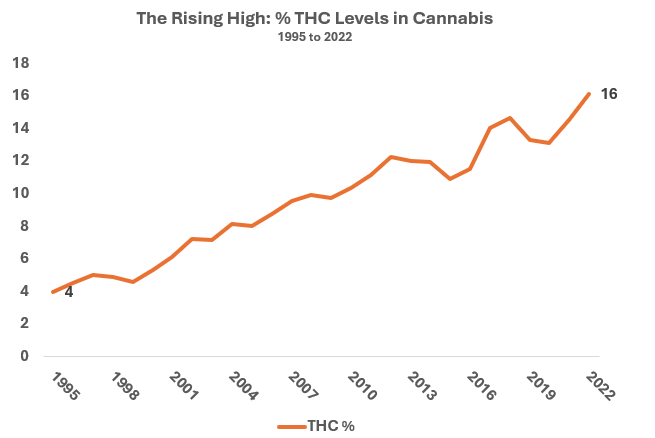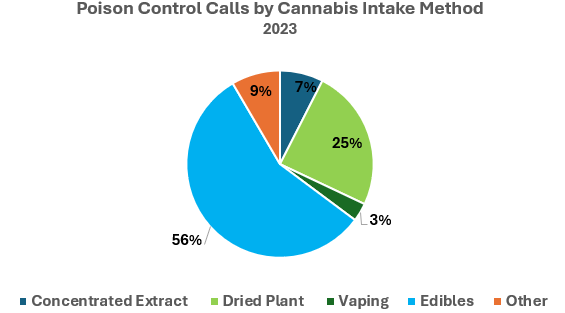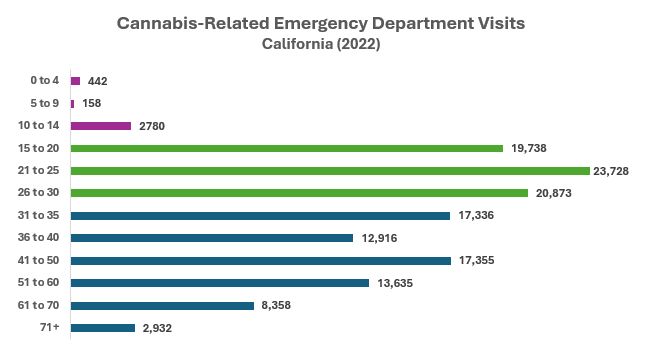The New Face of Marijuana: Evolution and Impact (Part III)
Following our previous analyses on youth substance use nationally and in the Bay Area, we now turn to marijuana—America's most widely used drug and increasingly a substitute for alcohol.
Marijuana's landscape has transformed through legalization, growing public acceptance, and commercialization. These changes haven't just expanded access; they've fundamentally altered the drug itself. Today's cannabis products feature dramatically increased potency, diverse consumption methods that appeal to younger users, and a persistent black market that undermines safety regulations.
Understanding these rapid changes and their implications is essential as parents, policymakers, and communities navigate this evolving terrain.
____________________
Part 1: Overview of Marijuana Use
To understand the current marijuana landscape, we examine the dramatic shifts in public opinion, consumption patterns, and user motivations that have occurred over the past decade.
Growing Acceptance and Usage
According to Gallup polling, marijuana use and public approval have risen dramatically:
15% of Americans now identify as cannabis users, more than double the level reported in 2013
Alongside increasing usage, public approval for legalization has also reached unprecedented levels:
68% of Americans believe marijuana should be legal, a remarkable increase from just 12% in 1969
____________________
Motivations for Cannabis Use
Research from New Frontier Data reveals that the primary reasons people report using cannabis are:
Relaxation
Stress relief
Anxiety reduction
These motivations suggest many users view cannabis primarily as a tool for emotional relief and well-being rather than as a purely recreational substance.
____________________
Popular Cannabis Products
The cannabis market has diversified significantly, with several product categories emerging as consumer favorites beyond traditional cannabis flower. According to data from California's Department of Cannabis Control, these products have seen the largest market share growth over the past five years:
Vape products (42% market share growth)
Pre-roll products (72% market share growth)
Edibles including gummies, baked goods, and beverages (10% market share growth)
Notably, the vast majority of the products gaining market share have higher potency levels than traditional smoked flowers.
____________________
Part II: Cannabis Potency and Risks
The rapidly evolving cannabis industry has transformed marijuana from a relatively simple plant into a diverse array of increasingly potent products.
Traditional Cannabis and Increasing THC Concentrations
THC (Tetrahydrocannabinol) is the primary psychoactive compound in cannabis responsible for producing the "high" sensation.
The potency of cannabis products has increased dramatically over time:
Data from the Drug Enforcement Administration (DEA) reveals a four-fold increase in THC concentration in cannabis samples seized over recent decades, rising from 4% in 1995 to 16% in 2022
Many products advertise THC concentrations of up to 90%, a dangerously high level associated with increased risk of psychosis
____________________
Implications of Increased Potency
This substantial increase in THC levels creates serious health and safety concerns:
More intense psychoactive effects leading to unpredictable reactions and anxiety
Greater risk of addiction and dependency with regular high-potency use
Heightened impairment affecting driving ability and cognitive function
Severe impacts on developing adolescent brains, which are especially vulnerable
California's illicit market (an estimated 75% of sales) compounds health risks by bypassing testing requirements. High taxes drive consumers to cheaper unregulated products, with the Department of Cannabis Control confirming "the black market is very pervasive and definitely larger than the legal market."
____________________
Part III: Documented Health Consequences
As cannabis products become more potent and widely available, healthcare systems are recording significant increases in adverse events.
Poison Control Incidents: Children at Risk
Cannabis-related calls to California Poison Control Centers highlight increasing risks:
163% increase in cannabis-related calls from 2016 to 2023
Children under 5 show the most alarming increase at 469% increase
Ages 6-19 saw a 147% increase
Adults (20+) experienced a 68% increase
Edible products represent the primary cause of pediatric cannabis exposure and Poison Control calls:
Candy-like appearance and sweet flavors attract young children and youth
Packaging often resembles common snacks
Delayed onset of effects can lead to accidental overconsumption
Emergency Department Visits
Data from the California Department of Public Health reveals cannabis-related emergency department visits have risen to around 140,000 annually, with clear age-based patterns:
46% occur among adolescents and young adults (ages 15-30)
52% involve adults over 30
2% affect children 14 and under
Mental Health Implications
A growing body of research links high-potency cannabis use with mental health concerns:
Increased incidence of anxiety and depression symptoms
Rising cases of cannabis-induced psychosis, particularly among adolescents
Potential triggering of underlying mental health conditions
The Wall Street Journal has reported an increase in marijuana-related psychosis cases among teenagers, highlighting a concerning trend that merits further investigation and attention.
____________________
Conclusion
Today's marijuana landscape has transformed through legalization, commercialization, and product innovation. These changes have led to some notable health consequences:
Key concerns:
Higher THC potency is associated with increased risks of addiction, psychosis, and cognitive effects, reflected in emergency department data
New product formats make cannabis more accessible, appealing, and potent
Children are increasingly exposed to cannabis products, with poison control centers reporting dramatic increases in accidental pediatric ingestions
The substantial illicit market operates outside safety regulations, resulting in quality and contamination concerns
The evidence points to emerging public health challenges that warrant attention from parents, adult users, policymakers, and communities as a whole.









